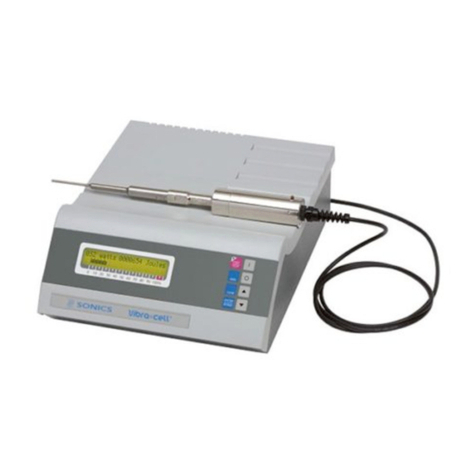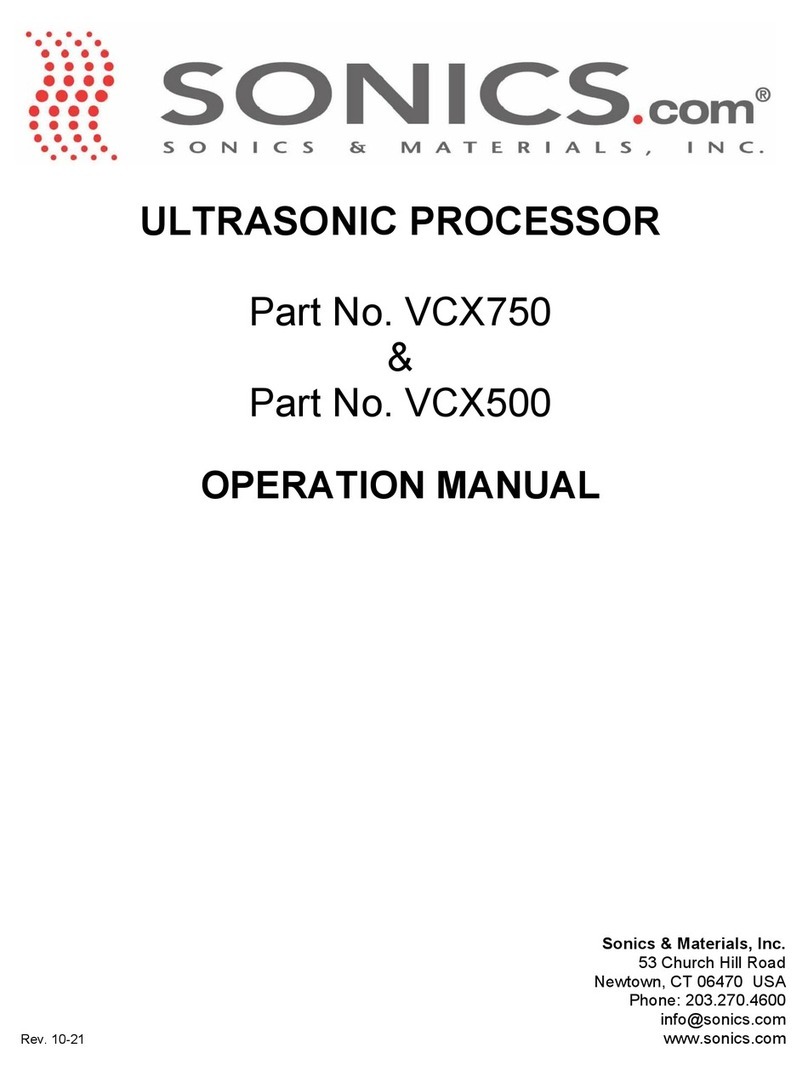Sonics VC50 User manual

Sonics & Materials, Inc.
53 Church Hill Road
Newtown, CT 06470 USA
Phone: 203.270.4600
Rev. 8-21 www.sonics.com
ULTRASONIC PROCESSOR
Part No. VC50
OPERATION MANUAL

Page 2 of 20
TABLE OF CONTENTS
1. WARRANTY ............................................................................................................. 3
2. WARNINGS .............................................................................................................. 4
3. SPECIFICATIONS .................................................................................................... 5
4. PRINCIPLES OF OPERATION ................................................................................ 7
5. DESCRIPTIONS OF COMPONENTS / FUNCTIONS OF CONTROLS .................. 8
5.1. VC50 SYSTEM ................................................................................................. 8
5.2. VC50 FRONT PANEL ...................................................................................... 8
5.3. VC50 REAR PANEL ......................................................................................... 8
5.4. FUNCTIONS OF KEYS CONTROLS AND CONNECTORS ............................ 9
5.5. CONVERTER CLAMPING ............................................................................. 10
6. PREPARATION FOR USE ..................................................................................... 11
INSPECTION .......................................................................................................... 11
ELECTRICAL REQUIREMENTS ............................................................................ 11
INSTALLING THE ULTRASONIC PROCESSOR ................................................... 11
7. OPERATING INSTRUCTIONS............................................................................... 12
7.1. CAUTION ....................................................................................................... 12
7.2. SETUP ........................................................................................................... 12
7.3. OPERATION .................................................................................................. 13
8. MAINTENANCE ..................................................................................................... 14
8.1. PROBE MAINTENANCE ................................................................................ 14
8.2. ATTACHING AND DETACHING MICROTIPS ............................................... 15
8.3. SYSTEM CLEANING INSTRUCTIONS .......................................................... 16
9. TROUBLESHOOTING ........................................................................................... 16
10. RETURN OF EQUIPMENT .................................................................................... 17
11. SAFETY CERTIFICATION FORM ......................................................................... 18
12. FREQUENTLY ASKED QUESTIONS .................................................................... 19

Page 3 of 20
WARRANTY
Your Ultrasonic Processor is warranted and backed by the manufacturer for a period of 3 years
from the date of shipment against defects in material and workmanship under normal use as
described in this instruction manual. During the warranty period, the manufacturer will, at its
option, as the exclusive remedy, either repair or replace without charge for material and labor,
the part(s) which prove to be defective, provided the unit is returned to us properly packed with
all transportation charges prepaid.
Ultrasonic probes are guaranteed against defects for a period of one year from date of
shipment. A defective probe will be replaced once without charge, if failure occurs within the
warranty period. Wear resulting from cavitation erosion is a normal consequence of ultrasonic
processing, and is not covered by this warranty.
The manufacturer neither assumes nor authorizes any person to assume for it any other
obligations or liability in connection with the sale of its products. The manufacturer hereby
disclaims any warranty of either merchantability or fitness for a particular purpose. No person or
company is authorized to change, modify, or amend the terms of this warranty in any manner or
fashion whatsoever. Under no circumstances shall the manufacturer be liable to the purchaser
or any other person for any incidental or consequential damages or loss of goodwill, production,
or profit resulting from any malfunction or failure of its product.
This warranty does not apply to equipment that has been subject to unauthorized repair,
misuse, abuse, negligence or accident. Equipment which, shows evidence of having been used
in violation of operating instructions, or which has had the serial number altered or removed, will
be ineligible for service under this warranty.
All probes are manufactured to exacting specifications and are tuned to vibrate at a specific
frequency. Using an out-of-tune probe will cause damage to the equipment and may result in
warranty nullification. The manufacturer assumes no responsibility for probes fabricated by
another party or for consequential damages resulting from their usage.
The aforementioned provisions do not extend the original warranty period of any product that
has either been repaired or replaced by the manufacturer.

Page 4 of 20
WARNINGS
Please read the manual in its entirety. Necessary instruction and guidance are provided to help
ensure the successful operation of this device. Observe the following:
High voltage is present in the power supply, converter and high frequency cable. There are no user-serviceable
parts inside any of these devices. Do NOT attempt to remove the power supply cover or converter case.
Do NOT touch any open cable connections on the unit while the power is turned ON.
Do NOT operate power supply with converter disconnected from high voltage cable. High voltage is present in
the cable and may pose a shock hazard.
Do NOT attempt to disconnect the converter high voltage cable while the unit is running.
The power supply must be properly grounded with a 3-prong plug. Test electrical outlet for proper grounding
prior to plugging in unit.
Install the ultrasonic power supply in an area free from excessive dust, dirt, explosive or corrosive fumes and
protected from extremes in temperature and humidity. (See page 5 for specifications) Do not place the power
supply within a Fume Hood.
Hearing protection is highly recommended. It is recommended that a sound abating enclosure or ear protection
be used when operating the Ultrasonic Processor
NEVER immerse the converter in liquids of any kind, or let condensed moisture or liquid drip into the converter.
NEVER grasp an activated probe or touch the tip of a vibrating probe. It can cause severe burns and tissue
damage.
NEVER allow a horn/probe to vibrate in air.
NEVER hold or clamp the converter by the front driver or by the probe itself. This can cause permanent damage
to the system. Support the converter by only clamping around the converter housing (upper portion).
Do NOT allow the tip of a vibrating horn or probe to touch the counter top or any other hard surface. It could
damage the probe, overload the power supply, or damage the surface.
Avoid touching the bottom or sides of a sample vessel with an activated probe. It may crack or shatter the glass
or melt the plastic. Use glassware that is free from cracks or chips.
Turn OFF the power switch, unplug the power supply and disconnect the power cord from the back of the power
supply before attempting to replace the fuses.
Inspect high frequency cable for cracks in the protective outer jacket.
Do not operate unit with a damaged cable. Doing so may cause serious injury.
In case of AC power loss, wait 3 minutes minimum before reapplying power.
Do not turn off Main power switch while running a probe. Stop sonication only by using the START/STOP key
Symbols
Caution, Risk of electric shock, Hazardous voltage.
Caution, Risk of danger. Refer to User Manual.

Page 5 of 20
SPECIFICATIONS
AC Adapter
Input Voltage 90 VAC - 264 VAC @ 50/60 Hz 1.5A
Output Voltage 24V DC, 3.75A
Rated Power 90 Watts
Power Supply
Input Voltage
24 VDC
Rated Power 50 Watts
Weight
3 lbs. (1.36 Kg)
Dimensions
8"W x 7.5"L x 5.75"H
200mm x 190mm x 146mm
Output Voltage
250 VRMS
Output Frequency
20 KHz
Converter
Weight
0.75 lbs. (0.34Kg)
Dimensions
6" L x 1.25" Dia.
(15cm x 3cm)
Materials
Aluminum Alloy
Standard 1/8” Probe
Weight
0.25 lbs. (0.11Kg)
Dimensions
5.4" L x 0.5" Dia.
(13.8cm x 1.3cm)
Materials
Titanium Alloy

Page 6 of 20
Environmental
Pollution Degree
2
Installation Category
II
Operating Limits
Shipping/Storage
Temperature: 41 - 104ºF (5 - 40ºC)
Relative Humidity 10 - 95% (Non Condensing)
Altitude: 6,651 ft. (2000 m)
Temperature: 35 -120 ºF (2 - 49 ºC)
Relative Humidity 10 - 95% (Non Condensing)
Ambient Pressure Extremes: 40,000 ft. (12,192 m)
Restriction of
Hazardous
Substances (ROHS)
Relative humidity Maximum relative humidity 80% for temperatures up to 31ºC decreasing
linearly to 50% relative humidity to 40ºC
Other For indoor use only
The AC Adapter supplied with the ultrasonic processor must be used. If the 230VAC plug is not
configured to match the wall receptacle, a properly grounded universal AC socket adapter must be
added.
Important: Universal adapters do not convert voltage or frequency. Manufacturer is not responsible for
damage caused by the use of an improper power cord or adapter. Transformers are not recommended.
WEEE Statement
This product contains electrical or electronic materials. The presence of these materials may, if
not disposed of properly, have potential adverse effects on the environment and human health.
Presence of this label on the product means it should not be disposed of as unsorted waste and
must be collected separately. As a consumer, you are responsible for ensuring that this product
is disposed of properly. To find out how to properly dispose of this product contact Customer
Service.

Page 7 of 20
PRINCIPLES OF OPERATION
The ultrasonic electronic generator transforms DC line power to a 20 KHz signal that drives a
piezoelectric converter/transducer. This electrical signal is converted by the transducer to a
mechanical vibration due to the characteristics of the internal piezoelectric crystals.
The vibration is amplified and transmitted down the length of the probe where the tip
longitudinally expands and contracts. The distance the tip travels is dependent on the
amplitude/intensity setting selected by turning the output control knob. As you increase the
amplitude setting the sonication intensity will increase within your sample.
In liquid, the rapid vibration of the tip causes cavitation, the formation and violent collapse of
microscopic bubbles. The collapse of thousands of cavitation bubbles releases tremendous
energy in the cavitation field. The erosion and shock effect of the collapse of the cavitation
bubble is the primary mechanism of fluid processing.
The probe tip diameter dictates the amount of sample that can be effectively processed.
Smaller tip diameters deliver high intensity sonication but the energy is focused within a small,
concentrated area. Probes with larger tip diameters can process larger volumes, but offer lower
intensity.
The choices of a power supply and horns/probes are matched to the volume, viscosity and other
parameters of the particular application. Horns are available for both direct and indirect
sonication. The frequently asked questions (FAQ) section has more information on this subject.
Please consult with a product specialist for assistance with selecting a probe for your
application.

Page 8 of 20
DESCRIPTIONS OF COMPONENTS / FUNCTIONS OF CONTROLS
5.1. VC50 SYSTEM
5.2. VC50 FRONT PANEL
5.3. VC50 REAR PANEL
Footswitch
Jack
Converter Cable
Connector
DC Power
Input
Power Supply
Converter
1/8” Probe
(#630-0422)
Converter
Cable
Lab Stand
with Clamp
(sold separately)
INTENSITY
CONTROL
KNOB
ON/OFF
switch

Page 9 of 20
5.4. FUNCTIONS OF KEYS CONTROLS AND CONNECTORS
FRONT PANEL
Power Switch
ON Position – energizes the power supply.
OFF Position – de-energizes the power supply.
Illuminates when the power supply is energized
Amplitude Control Knob Controls the amplitude/intensity of vibrations at the probe tip
REAR PANEL
Footswitch Jack/Connector Connects to the optional footswitch cable.
Converter Cable Connector
(Output) Connects the power supply output to the converter.
DC Power (Input)
Adapter Connector Connects the power supply to the DC adapter.

Page 10 of 20
5.5. CONVERTER CLAMPING
Improper clamping can damage the system and void the warranty. Using a sound enclosure
(part #830-00451) or stand (part #830-00460) will ensure a proper fit.
Proper Clamping Improper Clamping
Sound Enclosure
Part no. 8
30
-
0
0451
Clamp and Stand
Part no. 830-00460
Table of contents
Other Sonics Computer Hardware manuals
Popular Computer Hardware manuals by other brands

EMC2
EMC2 VNX Series Hardware Information Guide

Panasonic
Panasonic DV0PM20105 Operation manual

Mitsubishi Electric
Mitsubishi Electric Q81BD-J61BT11 user manual

Gigabyte
Gigabyte B660M DS3H AX DDR4 user manual

Raidon
Raidon iT2300 Quick installation guide

National Instruments
National Instruments PXI-8186 user manual













